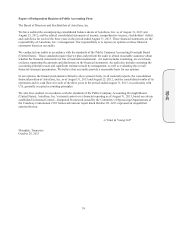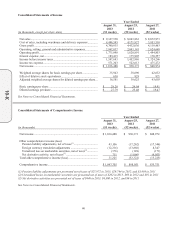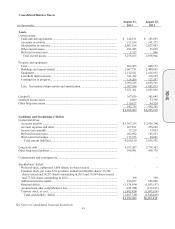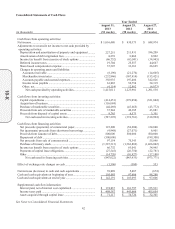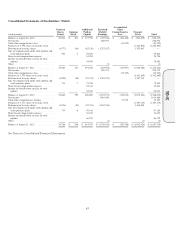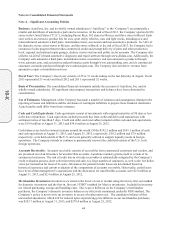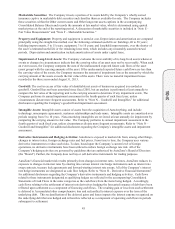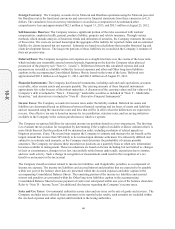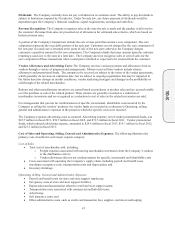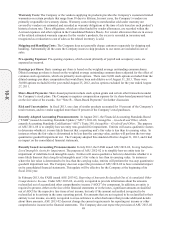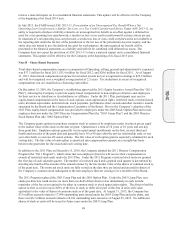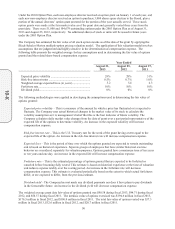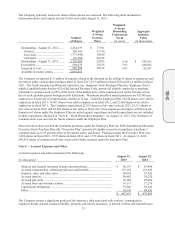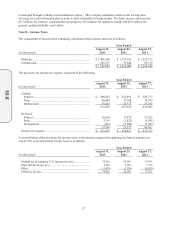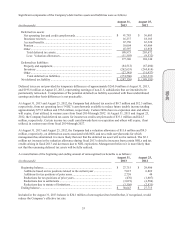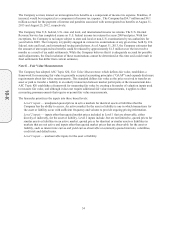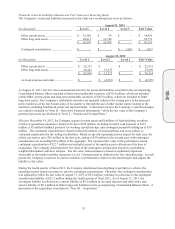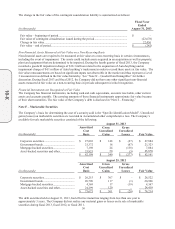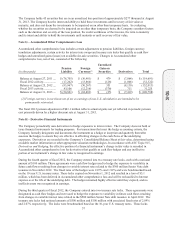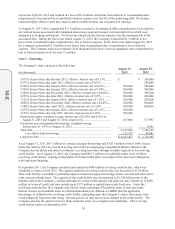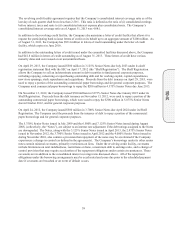AutoZone 2013 Annual Report Download - page 111
Download and view the complete annual report
Please find page 111 of the 2013 AutoZone annual report below. You can navigate through the pages in the report by either clicking on the pages listed below, or by using the keyword search tool below to find specific information within the annual report.
49
to have a material impact on its consolidated financial statements. This update will be effective for the Company
at the beginning of its fiscal 2014 year.
In July 2013, the FASB issued ASU 2013-11, Presentation of an Unrecognized Tax Benefit When a Net
Operating Loss Carryforward, a Similar Tax Loss, or a Tax Credit Carryforward Exists. Under ASU 2013-11, an
entity is required to disclose a liability related to an unrecognized tax benefit as an offset against a deferred tax
asset for a net operating loss carryforward, a similar tax loss or tax credit carryforward if certain criteria are met.
In situations of a net operating loss carryforward, a similar tax loss or a tax credit carryforward is not available at
the reporting date under the tax law of the jurisdiction or the tax law of the jurisdiction does not require, and the
entity does not intend to use, the deferred tax asset for such purpose, the unrecognized tax benefit will be
presented in the financial statements as a liability and will not be combined with deferred tax assets. The
Company does not expect the provision of ASU 2013-11 to have a material impact on its consolidated financial
statements. This update will be effective for the Company at the beginning of its fiscal 2015 year.
Note B – Share-Based Payments
Total share-based compensation expense (a component of Operating, selling, general and administrative expenses)
was $37.3 million for fiscal 2013, $33.4 million for fiscal 2012, and $26.6 million for fiscal 2011. As of August
31, 2013, share-based compensation expense for unvested awards not yet recognized in earnings is $25.9 million
and will be recognized over a weighted average period of 2.5 years. Tax deductions in excess of recognized
compensation cost are classified as a financing cash inflow.
On December 15, 2010, the Company’s stockholders approved the 2011 Equity Incentive Award Plan (the “2011
Plan”), allowing the Company to provide equity-based compensation to non-employee directors and employees
for their service to AutoZone or its subsidiaries or affiliates. Under the 2011 Plan, participants may receive
equity-based compensation in the form of stock options, stock appreciation rights, restricted stock, restricted stock
units, dividend equivalents, deferred stock, stock payments, performance share awards and other incentive awards
structured by the Board and the Compensation Committee of the Board. Prior to the Company’s adoption of the
2011 Plan, equity-based compensation was provided to employees under the 2006 Stock Option Plan and to non-
employee directors under the 2003 Director Compensation Plan (the “2003 Comp Plan”) and the 2003 Director
Stock Option Plan (the “2003 Option Plan”).
The Company grants options to purchase common stock to certain of its employees under its plan at prices equal
to the market value of the stock on the date of grant. Options have a term of 10 years or 10 years and one day
from grant date. Employee options generally vest in equal annual installments on the first, second, third and
fourth anniversaries of the grant date and generally have 30 or 90 days after the service relationship ends, or one
year after death, to exercise all vested options. The fair value of each option grant is separately estimated for each
vesting date. The fair value of each option is amortized into compensation expense on a straight-line basis
between the grant date for the award and each vesting date.
In addition to the 2011 Plan, on December 15, 2010, the Company adopted the 2011 Director Compensation
Program (the “2011 Program”), which states that non-employee directors will receive their compensation in
awards of restricted stock units under the 2011 Plan. Under the 2011 Program, restricted stock units are granted
the first day of each calendar quarter. The number of restricted stock units granted each quarter is determined by
dividing one-fourth of the amount of the annual retainer by the fair market value of the shares of common stock as
of the grant date. The restricted stock units are fully vested on the date they are issued and are paid in shares of
the Company’s common stock subsequent to the non-employee director ceasing to be a member of the Board.
The 2011 Program replaced the 2003 Comp Plan and the 2003 Option Plan. Under the 2003 Comp Plan, non-
employee directors could receive no more than one-half of their director fees immediately in cash, and the
remainder of the fees was required to be taken in common stock or stock appreciation rights. The director had the
option to elect to receive up to 100% of the fees in stock or defer all or part of the fees in units with value
equivalent to the value of shares of common stock as of the grant date. At August 31, 2013, the Company has
$7.6 million accrued related to 17,990 outstanding units issued under the 2003 Comp Plan and prior plans, and
there was $6.7 million accrued related to 18,241 outstanding units issued as of August 25, 2012. No additional
shares of stock or units will be issued in future years under the 2003 Comp Plan.
10-K


